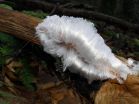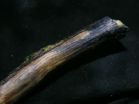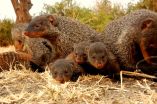(Press-News.org) You may have never seen or heard of it, but hair ice - a type of ice that has the shape of fine, silky hairs and resembles white candy floss - is remarkable. It grows on the rotten branches of certain trees when the weather conditions are just right, usually during humid winter nights when the air temperature drops slightly below 0°C. Now, a team of scientists in Germany and Switzerland have identified the missing ingredient that gives hair ice its peculiar shape: the fungus Exidiopsis effusa. The research is published today (22 July) in Biogeosciences, an open access journal of the European Geosciences Union (EGU).
"When we saw hair ice for the first time on a forest walk, we were surprised by its beauty," says Christian Mätzler from the Institute of Applied Physics at the University of Bern in Switzerland. "Sparked by curiosity, we started investigating this phenomenon, at first using simple tests, such as letting hair ice melt in our hands until it melted completely."
Then Mätzler, a physicist, joined forces with a chemist (Diana Hofmann) and a biologist (Gisela Preuß) in Germany. Inspired by earlier work, and by photographs of hair ice sent in from various countries, the team performed a set of experiments to figure out just what conditions are needed to grow this type of ice and what its properties are. In the process, they confirmed a 100-year-old theory for the origin of hair ice.
Alfred Wegener, of tectonic-plate fame, was the first to study hair ice. In 1918, he noticed a whitish cobwebby coating on the surface of hair-ice-bearing wood, which his assistant identified as fungus mycelium - the mass of thin threads from where mushrooms grow. He suggested there was a relation between the ice and the fungus in the wood. Some 90 years later, Gerhart Wagner, a retired Swiss professor who has been researching hair ice for decades, found evidence of this relation: treating the wood with fungicide or dunking it in hot water suppressed the growth of hair ice. But the fungus species and the mechanism that drives the growth of hair ice was yet to be identified.
That was the aim of the researchers who have now published their work in Biogeosciences. Preuß studied samples of hair-ice-bearing wood collected in the winters of 2012, 2013 and 2014 in forests near Brachbach in western Germany. She analysed the wood samples using microscopic techniques and identified eleven different species of fungi. "One of them, Exidiopsis effusa, colonised all of our hair-ice-producing wood, and in more than half of the samples, it was the only species present," she says.
Mätzler, on the other hand, performed experiments designed to better understand the physics of hair ice on samples he collected in a forest at Moosseedorf, Switzerland. He found, confirming guesses by other researchers, that the driving mechanism responsible for producing ice filaments at the wood surface is ice segregation. Liquid water near the branch surface freezes in contact with the cold air, creating an ice front and 'sandwiching' a thin water film between this ice and the wood pores. Suction resulting from repelling intermolecular forces acting at this 'wood-water-ice sandwich' then gets the water inside the wood pores to move towards the ice front, where it freezes and adds to the existing ice. "Since the freezing front is situated at the mouth of the wood rays, the shape of the growing ice is determined by the wood rays at their mouth," says Mätzler.
"The same amount of ice is produced on wood with or without fungal activity, but without this activity the ice forms a crust-like structure. The action of the fungus is to enable the ice to form thin hairs - with a diameter of about 0.01 mm - and to keep this shape over many hours at temperatures close to 0°C. Our hypothesis includes that the hairs are stabilised by a recrystallisation inhibitor that is provided by the fungus."
Hofmann then studied the hair ice itself. Her chemical analyses of the melted ice showed the water to contain fragments of the complex organic compounds lignin and tannin. Since these are metabolic products of the fungal activity, this finding further confirms the biological influence on hair ice. "These components may be the ones preventing the formation of large ice crystals at the wood surface," says Hofmann.
The researchers say a reason why it took almost 100 years to confirm Wegener's hypothesis is that hair ice is a somewhat rare and fleeting phenomenon, spotted mainly in broadleaf forests at latitudes between 45 and 55°N. "Hair ice grows mostly during the night and melts again when the sun rises. It's invisible in the snow and inconspicuous in hoarfrost," says Preuß.
Keep an eye out next time you go for an early morning walk in the woods. If you can find hair ice, you are in for a treat.
INFORMATION:
Please mention the name of the publication (Biogeosciences) if reporting on this story and, if reporting online, include a link to the paper (TBA) or to the journal website.
Wealthy people may be likely to oppose redistribution of wealth because they have biased information about how wealthy most people actually are, according to new research published in Psychological Science, a journal of the Association for Psychological Science. The findings indicate that people use their own neighborhoods and communities as a gauge of how much wealth other people possess, leading wealthy people to perceive the broader population as being wealthier than it actually is.
"If you're rich, there's a good chance you know lots of other rich people and relatively ...
New research based on modern techniques suggests that recommendations for protein intake in healthy populations may be incorrect. In a paper just published in Applied Physiology, Nutrition, and Metabolism, an NRC Research Press journal (a division of Canadian Science Publishing), researchers put the focus on protein as an essential component of a healthy diet. Protein helps people stay full longer, preserve muscle mass, and when combined with adequate physical activity, has the potential to serve as a key nutrient for important health outcomes and benefits.
It's not ...
For centuries it has been thought that culture is what distinguishes humans from other animals, but over the past decade this idea has been repeatedly called into question. Cultural variation has been identified in a growing number of species in recent years, ranging from primates to cetaceans. Chimpanzees, our closest living relatives, show the most diverse cultures aside from humans, most notably, in their use of a wide variety of tools.
The method traditionally used to establish the presence of culture in wild animals compares behavioural variation across populations ...
In their struggle to survive and prosper, multicellular organisms rely on a complex network of communication between cells, which in humans are believed to number about 40 trillion. Now, in a study published in Nature Communications, a research group led by scientists from the RIKEN Center for Life Science Technologies (CLST) has published an overall map of how the cells in the human body communicate by systematically analyzing the relationship between ligands--substances such as insulin and interferon that embody messages between cells, and receptors--the proteins on cell ...
A new review published in the Cochrane Library, indicates that eradicating Helicobacter pylori bacterium-- the main cause of stomach ulcers - with a short course of therapy comprising two commonly used medicines may help to reduce the risk of gastric cancer. Stomach, or gastric, cancer is the third most common cause of death from cancer worldwide, and people who are infected with the Helicobacter pylori bacterium are more likely to develop the disease.
About two-thirds of us have H. pylori in our bodies, but in most cases we experience no discomfort or other symptoms. ...
The US Family Smoking Prevention and Tobacco Control Act, passed in 2009, permits the U.S. Food and Drug Administration (FDA) to set standards for cigarette nicotine content. The FDA is accordingly supporting research into how very low nicotine content (VLNC) cigarettes might function as a regulatory measure to make cigarettes non-addictive, reduce smoke exposure, and improve public health, even among people who don't want to quit smoking.
New research published today in the scientific journal Addiction shows that simply reducing the nicotine content of cigarettes may ...
New research shows that HIV treatment for illicit drug users improves their social and socioeconomic wellbeing as well as their health.
While the health benefits of antiretroviral therapy (ART) for HIV are well documented, less is known about possible secondary benefits.
Lindsey Richardson, an assistant professor in the Department of Sociology at the University of British Columbia and research scientist with the BC Centre for Excellence in HIV/AIDS (BC-CfE), presented findings from two studies July 22 at the International AIDS Society (IAS) Conference in Vancouver. ...
Researchers studying wild banded mongooses in Uganda have discovered that these small mammals have either cooperative or selfish personalities which last for their entire lifetime. The findings of the 15-year study are published today in the journal Animal Behaviour.
The researchers investigated the selfish behaviour of mongoose mate-guarding - where dominant males guard particular females - and the cooperative behaviour of 'babysitting' and 'escorting' the young.
They found that cooperative mongooses that helped out with offspring care did so consistently over their ...
Regular consumption of sugar sweetened drinks is positively associated with type 2 diabetes independent of obesity status, finds a study published in The BMJ this week.
Artificially sweetened drinks and fruit juice also showed a positive association with type 2 diabetes, but the quality of evidence was limited. None the less, the authors warn that neither artificially sweetened drinks nor fruit juice are suitable alternatives to sugar sweetened drinks for the prevention of type 2 diabetes.
Artificially sweetened beverages have been seen as possible alternatives to ...
A low birth weight combined with an unhealthy lifestyle in adulthood are jointly related to an increased risk of type 2 diabetes, finds a study published in The BMJ this week.
The researchers say their findings emphasise the importance of adopting a healthy lifestyle to prevent the majority of type 2 diabetes cases in the population.
Diabetes has become a global epidemic, with an estimated 387 million living with diabetes and 4.9 million attributable deaths in 2014. Both unhealthy lifestyles and early life development have been implicated in the rapid rise of type 2 ...




